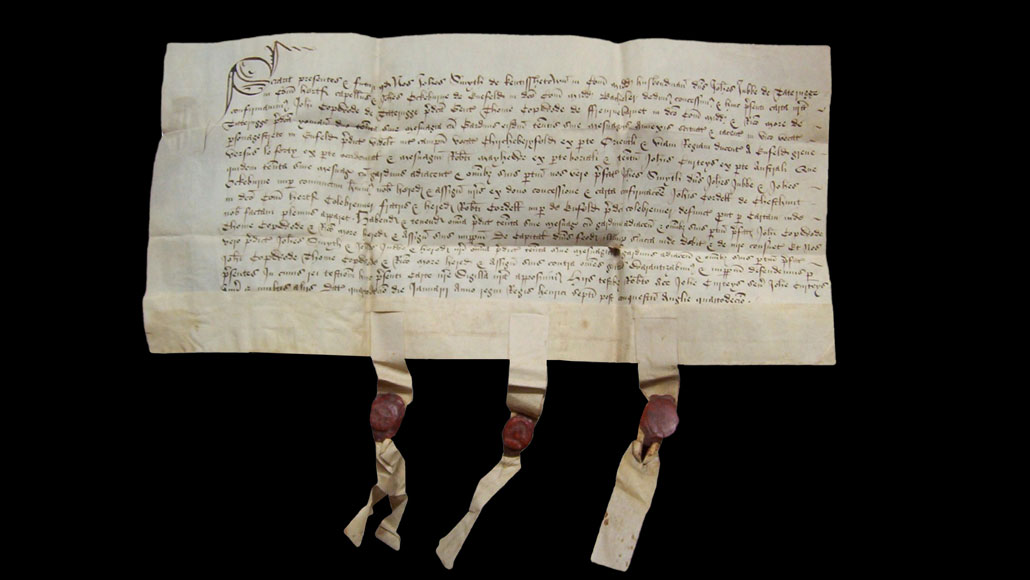maximus otter
Recovering policeman
- Joined
- Aug 9, 2001
- Messages
- 13,945
Fraudulent efforts to tweak legal documents in Great Britain may have been thwarted by the very parchment those documents were written on, a new study suggests.
Previous studies have shown that property deeds were written on a range of animal skins, such as goat, calf and sheep. But it turns out sheepskin was the parchment of choice, researchers report March 24 in Heritage Science. An analysis of proteins extracted from 645 samples from 477 British legal documents dating from the 16th to the 20th century shows that 622, or 96.4 percent, contained sheepskin.

This deed, involving ownership of land in Enfield, England, was written on parchment made from sheepskin and signed and sealed on January 15, 1499. Tampering with the ink on sheepskin would tear apart the layers of the skin, leaving a blemish on the parchment.
To make parchment out of animal skin, the skins are submerged in lime, a white powdery caustic soda, which removes the fat. Sheepskin has more fat — accounting for 30 to 50 percent of its weight — than other animal skins. (Cattle skin, for instance, is 2 to 3 percent fat.) So its removal leaves bigger gaps between the skin’s other layers. Scraping ink from this parchment can detach these loose layers, marring the surface and revealing changes to it.
Several 12th and 17th century documents describe sheepskin as useful in detecting changes to an original document, such as tampering with a property owner’s name. The new study adds to evidence that sheepskin helped to prevent fraudsters from pulling the wool over English officials’ eyes.
https://www.sciencenews.org/article/how-sheep-skin-legal-papers-fraud-prevention-parchment
See also palimpsest:
"...a manuscript page, either from a scroll or a book, from which the text has been scraped or washed off so that the page can be reused for another document. Parchment was made of lamb, calf, or goat kid skin and was expensive and not readily available, so in the interest of economy a page was often re-used by scraping off the previous writing. "
maximus otter
Previous studies have shown that property deeds were written on a range of animal skins, such as goat, calf and sheep. But it turns out sheepskin was the parchment of choice, researchers report March 24 in Heritage Science. An analysis of proteins extracted from 645 samples from 477 British legal documents dating from the 16th to the 20th century shows that 622, or 96.4 percent, contained sheepskin.

This deed, involving ownership of land in Enfield, England, was written on parchment made from sheepskin and signed and sealed on January 15, 1499. Tampering with the ink on sheepskin would tear apart the layers of the skin, leaving a blemish on the parchment.
To make parchment out of animal skin, the skins are submerged in lime, a white powdery caustic soda, which removes the fat. Sheepskin has more fat — accounting for 30 to 50 percent of its weight — than other animal skins. (Cattle skin, for instance, is 2 to 3 percent fat.) So its removal leaves bigger gaps between the skin’s other layers. Scraping ink from this parchment can detach these loose layers, marring the surface and revealing changes to it.
Several 12th and 17th century documents describe sheepskin as useful in detecting changes to an original document, such as tampering with a property owner’s name. The new study adds to evidence that sheepskin helped to prevent fraudsters from pulling the wool over English officials’ eyes.
https://www.sciencenews.org/article/how-sheep-skin-legal-papers-fraud-prevention-parchment
See also palimpsest:
"...a manuscript page, either from a scroll or a book, from which the text has been scraped or washed off so that the page can be reused for another document. Parchment was made of lamb, calf, or goat kid skin and was expensive and not readily available, so in the interest of economy a page was often re-used by scraping off the previous writing. "
maximus otter

